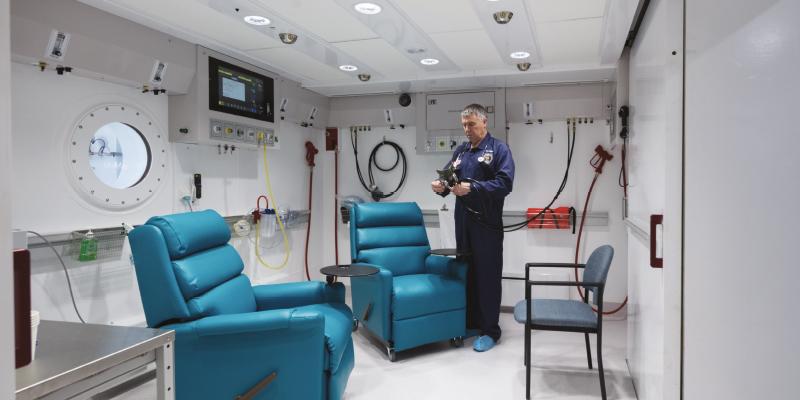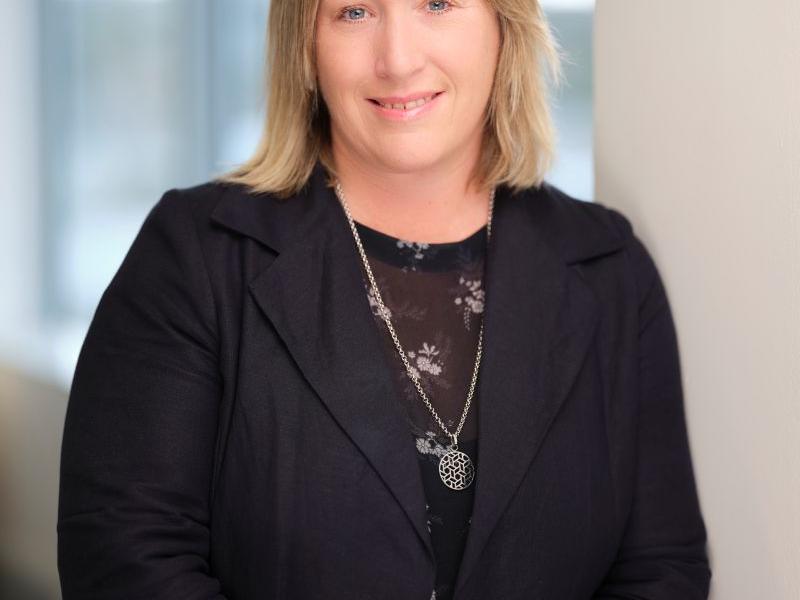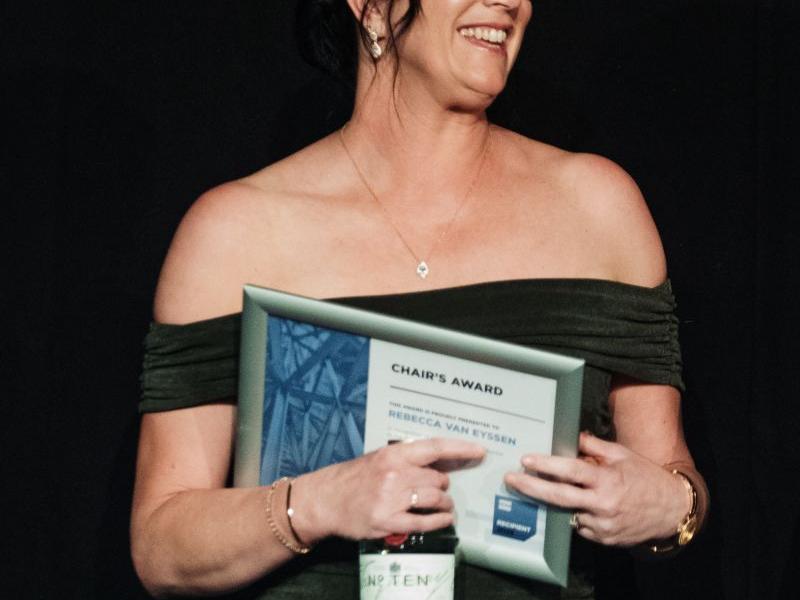The Royal Hobart Hospital in Tasmania, Australia recently opened its new Department of Diving and Hyperbaric Medicine featuring a new state-of-the-art dual capability hyperbaric chamber. Designed by Fink Engineering and powered by a Kaeser compressed air system, it is a first for the southern hemisphere – delivering patient treatment and a world-class research and training facility.
The Royal Hobart Hospital (RHH) is Tasmania’s largest hospital that provides a range of tertiary health services to the State of Tasmania. In May 2020, the RHH officially opened its new Department of Diving and Hyperbaric Medicine, State Referral Centre, featuring a new state-of-the-art hyperbaric chamber which boasts a greater capacity and capability for patient treatment as well as supplying a world-class research and training facility.
Treating patients with a medical hyperbaric chamber
A medical hyperbaric chamber is used to deliver Hyperbaric Oxygen Treatment (HBOT). HBOT is a well-known therapy for treating decompression illness and as such it is essential for commercial and recreational diving industries. In addition, it has been used for many years to treat patients with an array of medical conditions such as diabetic ulcers, tissue injury from radiation after treatment for cancer, osteoradionecrosis and serious infections such as gangrene. While most patients with such conditions will heal eventually by traditional methods, in addition to standard treatment, a course of HBOT can speed up and enhance the healing process for many patients.
HBOT works by increasing the partial pressure of oxygen in the blood and tissues. The patient sits or lies in a hyperbaric chamber where the pressure is increased to 2.4 atmospheres and is given 100 percent oxygen to breath via a mask or hood system. The high partial pressure of oxygen increases the diffusion distance that oxygen can penetrate into tissues. Repeated hyperoxic stimulation has proven to accelerate the healing process, where on average a patient undertakes around 20 to 40 treatments over the course of four to eight consecutive weeks.
A first for the southern hemisphere
The new hyperbaric chamber at RHH was designed and engineered by Fink Engineering. A world leader in hyperbaric technology, Fink Engineering is based in Queensland, Australia and pioneered the design and development of the rectangular shape for hyperbaric chambers back in 1994. It was the first company internationally to design such a chamber which has been used effectively ever since.
Unlike traditional cylindrical shaped and double locked hyperbaric chambers with a typical patient capacity of two to five patients, these rectangular shaped hyperbaric chambers feature a triple lock and can simultaneously treat up to 9-10 patients.
The new hyperbaric chamber now in operation at the RHH is also fitted with capability of depressurisation to simulate altitude. There are currently only a few dual capable chambers like it in the world. A first for the southern hemisphere, this can pressurise (hyperbaric) and depressurise (hypobaric). This means that aside from treating patients with its hyperbaric capabilities, the chamber can be used for altitude research and training using its hypobaric capabilities. It will be possible for researchers, for example in the aerospace sector, to study the effects of high altitude on the body, in particular low oxygen levels and low ambient air pressure.
Delivering high quality and high volumes of clean and medical breathing air
High quality, dry and clean compressed air is essential for a medical hyperbaric chamber to operate. Once patients have been fitted with a breathing mask or hood system, the doors to the hyperbaric chamber are closed. The atmospheric pressure inside the chamber is then increased by opening values which allow high pressure air to enter.
For many years, Fink Engineering has chosen Kaeser compressed air equipment to meet these requirements and in the case of RHH, two CSD 125 T rotary screw compressors with integrated refrigerant dryers along with a comprehensive air treatment package was chosen. As George Fink, Project and Maintenance Supervisor at Fink Engineering explains:
“The hyperbaric chambers require high quality and high volumes of clean and medical breathing air that meets Australian and New Zealand standards. It is essential that the air is medical grade and clean. Staff inside the chamber breathe pressurised air while attending to patients. Patients receive hyperbaric oxygen treatment while breathing from a mask or a hood. They also breathe the hyperbaric chamber air when taking short breaks during treatment.
“It is also essential that the compressed air system is reliable. Ultimately the last thing you would want is a compressor failure to stop the chamber functioning mid-treatment. That’s also a reason we choose to install a double redundancy system. That way there is always a backup compressor if required to supply the compressed air needed to finish a treatment.”
The compressed air solution for RHH
The CSD T series of rotary screw compressors with an integrated refrigeration dryer from Kaeser Compressors deliver premium compressed air quality.
The latest generation of CSD systems not only deliver more compressed air for less energy, but they also combine ease of use and maintenance with exceptional versatility and environmentally responsible design.
At the heart of every CSD system lies a premium quality airend featuring Kaeser’s Sigma Profile rotors. Flow-optimised for impressive performance, these advanced rotors help Kaeser CSD systems set the highest standards for efficiency.
Maximum performance and efficiency are further delivered thanks to the inclusion of a super-premium efficiency IE4 class motor as standard. Kaeser is currently the only compressed air systems provider to equip its compressors with super premium efficiency IE4 class motors.
The integrated refrigeration dryer provides high-efficiency performance thanks to its energy saving control. The dryer is therefore active only when compressed air actually needs to be dried: this approach consequently achieves the required compressed air quality with maximum efficiency. A Kaeser centrifugal separator fitted with an electronic Eco-Drain condensate drain installed upstream from the refrigeration dryer ensures that condensate is reliably pre-separated and drained, even when ambient temperatures and humidity are high.
Moreover, the refrigeration dryers are equipped with R-513A refrigerant, which has a very low GWP (Global Warming Potential) value. This means that these efficient dryers will be future-proof for their entire life cycle.
The compressors were complimented with a complete air treatment package. This included Kaeser filters – the key component to produce compressed air to all purity classes as per ISO 8573-1. The Kaeser Filter range uses modern deep-pleated filter media to remove particles and aerosols. A highly effective carbon fibre mat traps oil vapours. The outstanding performance data of Kaeser Filters has been calculated according to ISO 12500 and validated by Lloyd’s Register – the independent certification organisation.
Kaeser Filter products feature generously dimensioned housings and filter surfaces, innovative flow dynamics and high-performance filter media. They feature up to 50 percent lower pressure loss than other available filters – a value which remains virtually constant over the entire service life of the filter element. This means lower costs and CO2 emissions as well as reduced load on upstream compressors.
The CSD T series of rotary screw compressors with integrated refrigeration dryer models from Kaeser are available with drive powers of 45 to 75 kW and produce flow rates from 5.50 to 12.02 m3/min, designed for pressures 8.5 to 15 bar.
Details, Ph: 0800 447 820, nz.kaeser.com






